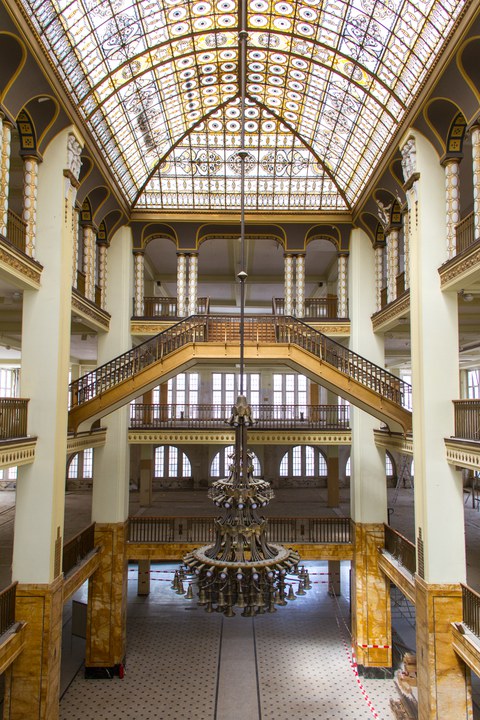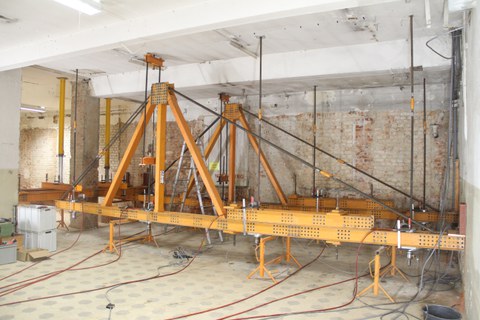Experimental load tests of slabs at the Görlitz department store
Table of contents
Project data
| Titel | Title Experimentelle Belastungsversuche der Stahlsteindecken im Kaufhaus Stöcker in Görlitz | Experimental load tests of slabs at the Görlitz department store Förderer | Funding Stöcker Kaufhaus GmbH & Co. KG, Görlitz Zeitraum | Period 03.2018 – 09.2018 Leiter | Project Manager Prof. Dr.-Ing. Dr.-Ing. E.h. Manfred Curbach (Institut für Massivbau, TU Dresden), Bearbeiter | Contributors Dipl.-Ing. (FH) Sabine Wellner, Dipl.-Ing. Oliver Mosig, Dr.-Ing. Torsten Hampel Versuchsdurchfühung | Test execution Dipl.-Ing. Oliver Mosig, Maik Patricny, Andreas Thieme, Heiko Wachtel, Bernd Wehner, Dipl.-Ing. (FH) Sabine Wellner |
Report in the annual report 2018
ALMOST LIKE IN A MOVIE - GÖRLITZ DEPARTMENT STORE

Ein Blick ins Innere des Kaufhauses Görlitz
The construction of the Görlitz department store began in 1912, according to the plans of the Potsdam architect Carl Schmanns. The 5-storey building, with about 10000 m² floor space, was erected as a steel skeleton structure. In addition to the façade, the elaborately and ornamentally decorated glass dome roof, which spans the atrium, features elements of Art Nouveau. With its marble-clad pillars, open staircases and two gigantic chandeliers, the building is the only surviving architectural testimony - in its original form - of the early German department store architecture. It is known as the scenery of the multiple Oscar-winning movie “The Grand Budapest Hotel”.
In preparation for the planned refurbishment and reopening of the department store, the load bearing capacity and serviceability of the ceilings had to be checked. Increased dead weight and traffic loads had to be taken into account.

Rahmenkonstruktion zur Lastableitung
Since this proof could not be provided mathematically, the Otto Mohr Laboratory carried out experimental load tests on a total of 10 ceilings in different storeys. The combination of large ceiling areas and high target loads of over 1 tonne per square metre required a complex test setup construction. Two steel frames served as abutments for secure anchoring of the load in the masonry of the department store. The hydraulic cylinders were attached to this construction, and they pulled down the ceiling above via tie rods. The load was evenly applied to the ceiling surface via cross beams and wooden boards. Several inductive displacement transducers tracked the deformation of the floor slab at various points under load in real time.
Load cells on the hydraulic cylinders provided information on the level of the load. The deformation behaviour of the ceiling could be observed by gradually increasing the load. The measured deformations were within the permissible range. Damage to the floor slab, such as wide cracks, could not be determined. The experimental proof of the ceiling structures could thus be provided, which was an important step for the planned reopening of the Görlitz department store.
